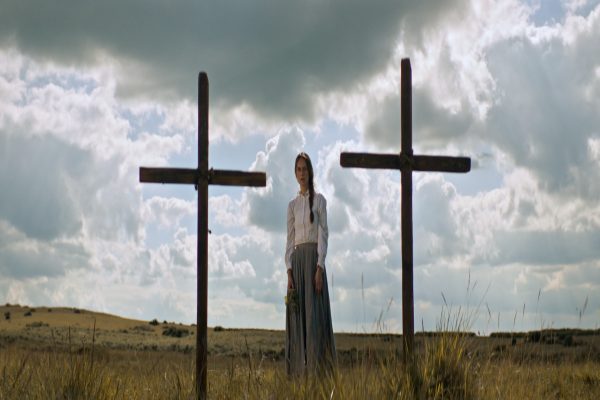Alone in the Minnesota wilderness, two sisters tend to their gravely ill third sister, who is seemingly unable to waken or breath properly, and who is exhibiting peculiar moods. Isolated from the rest of the world with nothing but prayer and owls for company, a stranger emerges from the distance – dying of thirst, apparently attacked. This Outcast, claiming to be a doctor, could save Ada’s life, but just how easy is it to trust a stranger? How desperate are Ingrid and Liv, and what else lurks in the barren landscapes in William Gillie’s Who Goes There?
For the most part, Gillie’s narrative follows Ingrid, the eldest sister, as she cares for Ada and maintains Liv’s sanity. A powerful presence, Nina Yndis tempers herself liberally, reacting in an authentic, commanding way but shows no restraint in expressing anxiety or fear in the presence of the Outcast or the prospect of using a shotgun. As the plot begins to grow ambitious, Yndis’ performance follows, generating extra energy, ferocity and control of the screen. The film culminates in an investable climax, managing to sell a developing supernatural angle without resorting to effects or obvious visuals and dialogue.
Producing an uncomfortable tension in the air, both Siri Meland and Liam McMahon as Ada and the Outcast conjure a relationship where something is off, but the audience can’t quite place a finger on what. Meland’s obsessive reliance on religious artefacts and constant praying are seen as a crutch, but also an unhealthy obsession. Walking directly out of True Grit or Unforgiven, McMahon’s swagger is something to behold, gradually descending into something more animalistic, visceral and reflective of the harsh landscape surrounding them.
Astrid Thorvaldsen’s direction usually maintains a steady pace, but steps a little heavily on the gas just before the film’s climax, jumping the gun slightly and giving away any twists with too much time left on the clock. Despite this, the characterisation arcs of the protagonists are structured well, with the primary leads developing in a short space of time.
Silence aids the film, even with the limited composition from Adam Speck, what little music is present throughout is kept to a minimum, serving to lift emotional tension. Rather, Who Goes There? bolsters its atmosphere with a spectacular sound design to offset the limited dialogue. Ines Andriana & Jôao Fonte capture great intensity in the minimalist design; crackling fires of the old-west, sinister whistles and rustles all aid in promoting a short thriller into a bleak, isolating horror.
The visual aesthetic follows suit, refraining from over saturating the photography, Graham Boonzaaier captures the emptiness of the plains surrounding the sisters. Much of the film is shot with a greyscale overlay, mostly devoid of colour except the occasional fire or the trickle of scarlet from an open wound. Gradually, as the film descends more and more into a supernatural element, a crimson hue replaces the grey, reflecting both the worry for Ada’s health and the growing concerns surrounding the Outcast.
A concentrated, thrilling piece, Who Goes There? steps up to the plate as a short film, carrying the necessary components for a fully-fledged feature, and often pulling them together more successfully. Dripping with tension, Gillie’s short film revels in the quieter moments, allowing the cast to breathe, grow and when able, naturally twist the tale in on itself, making audience’s question the kindness of strangers.
Screened as part of Fantasia Festival
